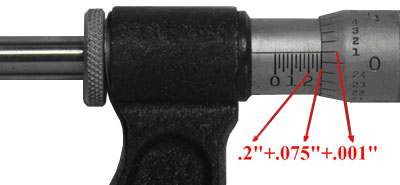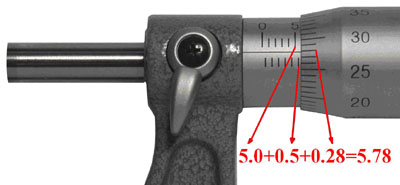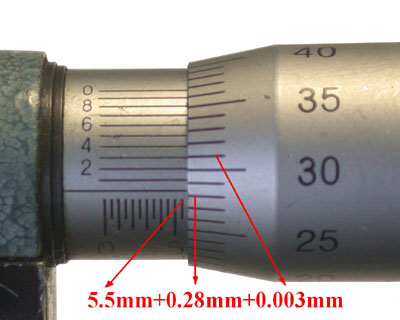Introduction
A micrometer generally provides greater precision than a caliper, but can measure a smaller range of lengths. Clean the measuring faces with a clean cloth before and after measurement.
Parts of an Outside Micrometer

How to Read an Outside Micrometer Graduated in 0.001"

Micrometer thimble showing 0.276 inch
The pitch of the screw thread on the spindle is 40 threads per inch. One revolution of the thimble advances the spindle
face toward or away from the anvil face precisely 1/40" or 0.025", equal to the distance between two graduations on the sleeve. The reading line on the sleeve is divided into 40 equal parts by vertical lines that correspond to the number of threads on the spindle.Therefore, each vertical line designates 1/40" or 0.025". Every fourth line, which is longer than than the others, designates 0.1".The beveled edge of the thimble is divided into 25 equal parts with each line representing 0.001" and every line or every fifth line numbered consecutively. To read the micrometer in thousandths, multiply the number of vertidal divisions visible on the sleeve by 0.025", and to this add the number of thousandths indicated by the line on the thimble which coincides with the central long line on the sleeve.
Suppose the thimble were screwed out so that graduation 2, and three additional sub-divisions, were visible (as shown in the image), and that graduation 1 on the thimble coincided with the central long line on the sleeve. The reading then would be 0.2000 + 0.075 + 0.001, or 0.276".
How to Read an Outside Micrometer Graduated in 0.01mm

Micrometer thimble reading 5.78mm
The pitch of the screw thread on the spindle is one-half millimeter(0.5mm). One revolution of the thimble advances the spindle face toward or away from the anvil face precisely 0.5mm. The reading line on the sleeve is graduated above the central long line in millimeters (1.0mm) with every fifth millimeter being numbered. Each millimeter is also divided in half(0.5mm) below the central long line.The beveled edge of the thimble is divided into fifty equal parts, with each line representing 0.01mm and every fifth line being numbered from 0-50. Thus, the reading is given by the number of millimetre and half-millimeter divisions visible on the sleeve plus the number of hundredths of a millimeter indicated by the thimble graduation which coincides with the central long line on the sleeve.
Suppose that the thimble were screwed out so that graduation 5, and one additional 0.5 subdivision were visible (as shown in the image), and that graduation 28 on the thimble coincided with the central long line on the sleeve. The reading then would be 5.00 + 0.5 + 0.28 = 5.78 mm.
How to Read Vernier Mircometer Graduated in 0.001mm or 0.0001"

Micrometer sleeve (with vernier) reading 5.783mm
Some micrometers are provided with a vernier scale on the sleeve in addition to the regular graduations. These permit measurements within 0.001 millimetre to be made on metric micrometers, or 0.0001 inches on inch-system micrometers.
The additional digit of these micrometers is obtained by finding the line on the sleeve vernier scale which exactly coincides with one on the thimble. The number of this coinciding vernier line represents the additional digit.
Thus, the reading for metric micrometers of this type is the number of whole millimetres (if any) and the number of hundredths of a millimetre, as with an ordinary micrometer, and the number of thousandths of a millimetre given by the coinciding vernier line on the sleeve vernier scale.
For example, a measurement of 5.783 millimetres would be obtained by reading 5.5 millimetres on the sleeve, and then adding 0.28 millimetre as determined by the thimble. The vernier would then be used to read the 0.003 (as shown in the image).
Inch micrometers are read in a similar fashion.
When using either a metric or inch micrometer, without a vernier, smaller readings than those graduated may of course be obtained by visual interpolation between graduations.
|

